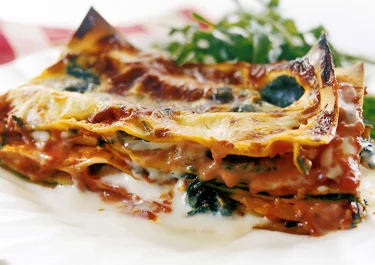
Spinach lasagne

Instructions
Spinach lasagne
Ingredients
Leaf spinach | 250 g |
|---|---|
Garlic cloves | 2 |
Butter | 1 tbsp |
Pasta sauce (approx. 400 g) | 1 jar |
Pasta sauce, mild cheese | 400 ml |
Fresh lasagne sheets | 8 |
Grated cheese, gratin | 70 g |
A classic lasagne with a green twist
While the true origin of lasagne is likely ancient Greece, it is the Italian pasta, ragu and bechamel combination that eventually became the most famous and popular. As it travelled the country, and the globe, its list of ingredients evolved and expanded into more iterations than you can probably imagine.
Different toppings and variations to customise your lasagne
Entire cookbooks are dedicated to this dish, illustrating just how versatile and loved lasagne is. The most traditional is of course the meat-based version that layers a saucy ragu with a creamy bechamel and al dente pasta sheets. Lasagna alla Norma is a popular variation from Sicily where fried eggplant replaces the pasta sheets, and a creamy ricotta is added to the layering. From Italy’s Marche region, vincisgrassi doesn’t have a definitive recipe but typical ingredients for the ragu include pancetta, prosciutto, and chicken giblets. Cheese will always be your best option from a topping perspective and we recommend anything from parmesan and torn buffalo mozzarella to Romano cheese and creamy ricotta.
Hide the greens from picky eaters
A tomato-based pasta sauce offers the perfect hiding place for spinach with the reds and greens combining into an inconspicuous brown that will fool even the most suspicious of eaters. One of the easiest methods is to add the cooked and drained leaves to the pasta sauce and blend it to a smooth purée. Finely chopping the spinach and adding it to the pasta sauce is also a good alternative and the ingredient will be difficult to distinguish when layered into the lasagne. If any questions do arise, the fine greens can relatively easily be explained away as an innocent herb. For both these methods, we recommend that you slightly reduce the amount of spinach to safely sail under the radar.
Store your leftover lasagne like this
Leftovers can be stored for up to four days in the refrigerator. Make sure that you use an airtight container and that it’s tightly sealed to prevent the cold air from drying out the dish.










